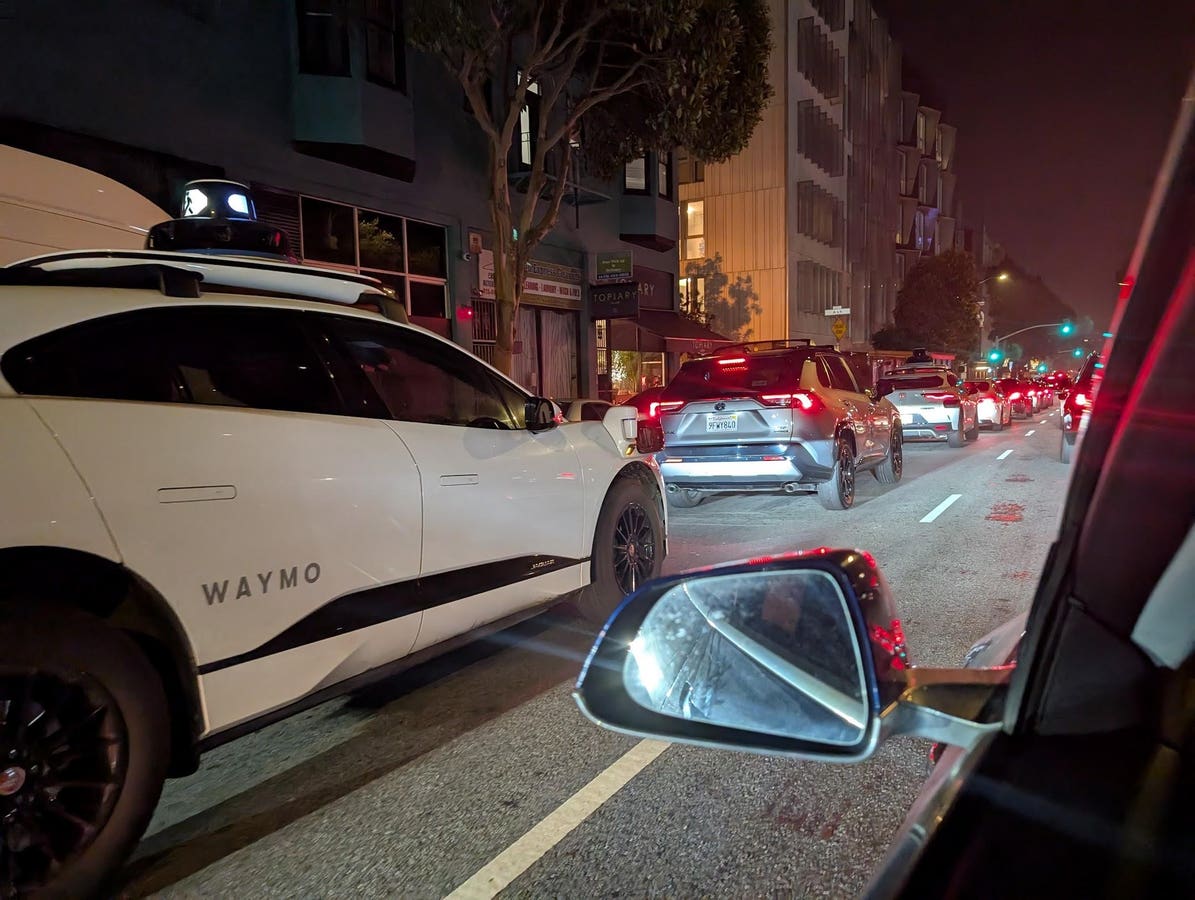Physical Address
304 North Cardinal St.
Dorchester Center, MA 02124
Physical Address
304 North Cardinal St.
Dorchester Center, MA 02124

There were at least 5 Waymos surrounding me on a recent drive through San Francisco. It’s not that … [+]
Waymo, the self-driving unit of Alphabet, announced recently that they are now providing 200,000 self-driving taxi rides every week with no safety driver in the car, only passengers. They also recently switched their service in Austin to be orderable only through the Uber app. In San Francisco and Phoenix, the dedicated Waymo One app continues to be the way to order rides.
Waymo isn’t alone, though since the departure of General Motors’ “Cruise” unit they are pretty close in the United States. Startup May Mobility offers self-driving rides in Ann Arbor with no safety driver, and in several other cities with safety drivers. They recently began service with no safety driver in Peachtree Corners, GA and will partner with Lyft to offer service in Atlanta via their app. May declined to give a ride count.
In China, though, several companies are giving rides with no safety driver. The dominant player is Baidu Apollo, which reports they did 1.1 million no-safety-driver rides last quarter, which is 84,000 per week. Pony.AI claims 26,000 per week, but it is not clear if all are with no safety driver. AutoX does not report numbers, but says it has 1,000 cars in operation. WeRide also does not report numbers.
Even with modest estimates for the companies making no reports, this tells us that around 1.3 million rides are being taken every month in robotaxis with no safety driver. Some people, who aren’t in one of the robotaxi cities, still think self-driving ars aren’t real, and that they won’t be here for many years, or may never come. The people in the robotaxi cities have gotten bored with them; they’re already just part of the landscape.
Most of the services look a lot like a taxi or Uber, and that’s led a lot of people to imagine that’s the goal of these project. Some services look a bit like shuttles or transit, and transit people often imagine robocars as a possible enabler for “last mile” travel on existing transit lines. Both ideas are very far from the truth. Yes, robotaxis will provide Uber like service, and yes, they will replace transit, but these are small potatoes. Some people even think the robotaxis will just work as Uber drivers because today you can summon them in the Uber app. No, they didn’t invest tens of billions to replace $22/hour Uber drivers or $27/hour truck drivers. The 1.3 million rides are still just experiments, to learn how people use the technology and how they value it.
Sure, Uber and Lyft may bring in almost $60B. That’s chicken feed (Photo by Michael M. … [+]
The goal is much grander. To replace most of the ground transportation industry, which today has revenues around $5 Trillion worldwide. That’s much more than even the giants like Google and Amazon and Baidu make from their tech businesses. They don’t want to replace Uber, or the cab driver, but the whole industry. While nobody will capture all of the market, and they will also make transportation cheaper, that means being all of these industries, because for the customer, all these things will be replaced:
So that means they don’t want to be Uber. They want to be Uber, Toyota, the dealer, Exxon, Pep Boys, State Farm, your transit agency, GMAC, UPS, Michelin and more–all combined. These are the companies you pay money to in the current transport industry. Of course, they will not do it all, they will contract with companies like these to provide components and services, but they will be in control, decide who does the service and who gets the money. And no one company will control it all–we certainly hope.
In the process, they’ll let us redefine where we live and work, how we get around and the very shape of our cities. Transportation has always done that, and each century has seen a transportation innovation – be it trains, cars or robocars, which reshaped the world.
Uber is partnering with Waymo both on the app to hail rides, and running depots. Waymo gets customers with no effort, and Uber learns more about running a service with robotaxis. They hope to repeat their success in being the broker that connects drivers with riders, but with the human drivers, they have the power and control the game They never will with Waymo–Alphabet dwarfs them as a company. Maybe they’ll find a working role, but make no mistake who will be working for who. We don’t call it the Foxconn iPhone, but it’s not bad to be Foxconn, either.
So no, it’s not just to make a robotic Uber driver. Nor, as many speculate because Google–an advertising company if you look at the balance sheet–was the pioneer, is it to monetize your attention with ads while you’re in the car. That would be the tail wagging the dog. Mobility is a much bigger industry than advertising.